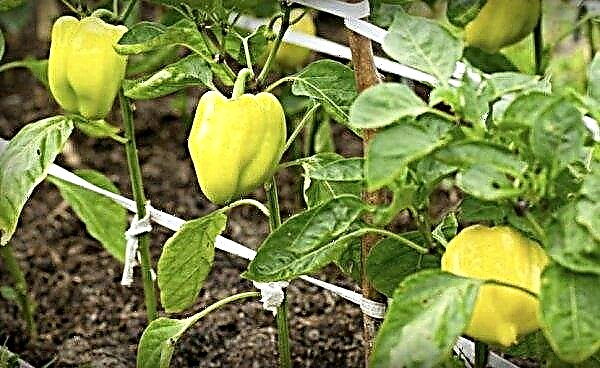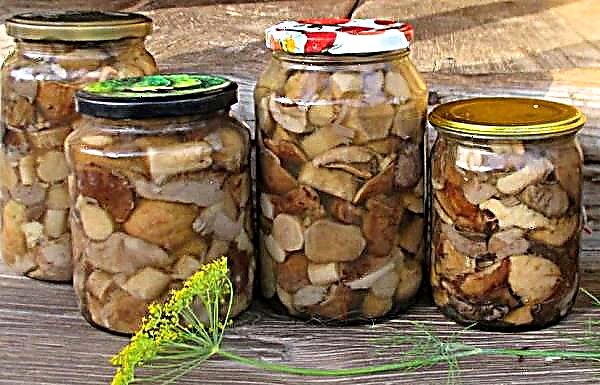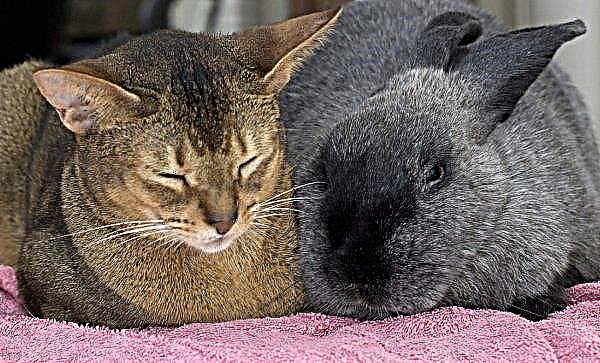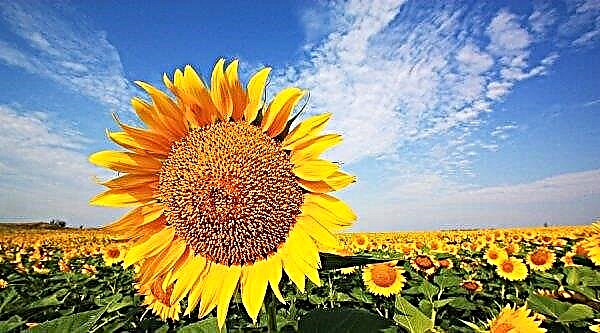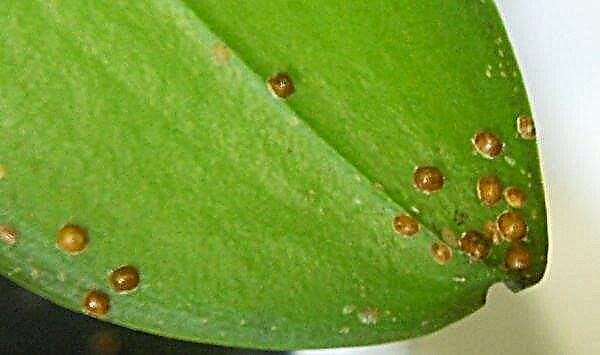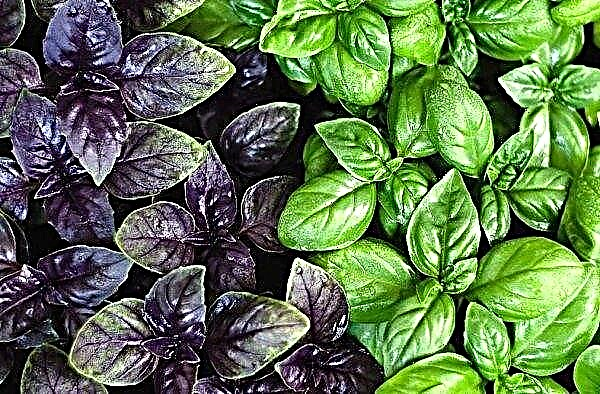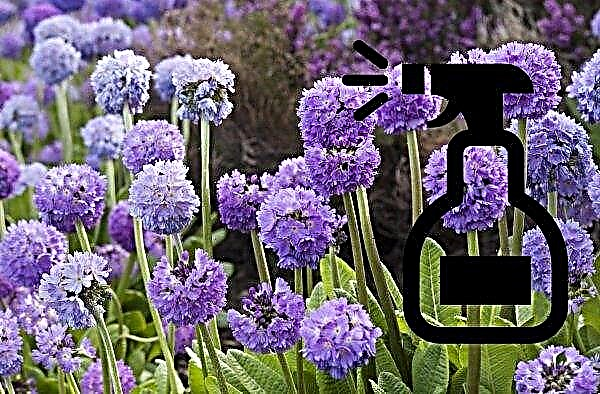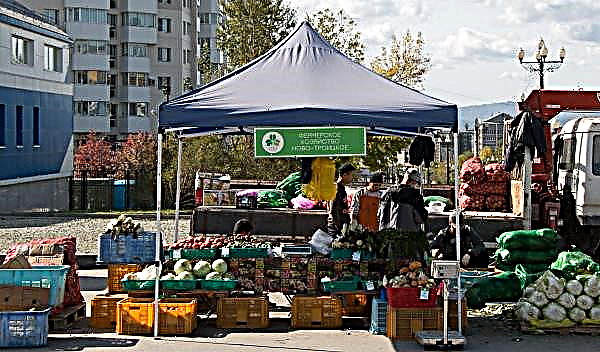The breed of large gray geese stands out among others and is one of the best. If you intend to have such birds, then you will need to know what they have advantages and disadvantages, how to handle them, what to feed.
Breed characteristics
These heavy meat-bearing poultry were bred by Ukrainian breeders in the 30s of the last century when crossing the Toulouse and Romance breeds and further improved in Russia. The result is 2 types of breed: Borkovsky (or Ukrainian) and Tambov (steppe).
Appearance
Gray geese can be recognized by the following characteristics:
| Head | massive, with a thick beak of red-orange color |
| Neck | average in length |
| Torso | wide |
| Chest | deep, with bulging muscles |
| Legs | orange |
| Paws | with wide-spread orange-red metatarsus |
| Plumage | gray, lighter on the chest, darker on the head, back and neck; in the abdomen and lower body it is white |
Pros and cons of the breed
Before acquiring gray geese, it is worth familiarizing yourself with their advantages and disadvantages. The breeders of the breed as a whole respond positively about its representatives and recommend the purchase of highly productive and unassuming poultry, from which it is possible to obtain the desired meat products in a short time.
- Among the advantages they also note:
- High fecundity.
- Fast weight gain.
- Suitability for fattening in order to obtain the liver.
- Well-developed maternal instinct.
- Suitable for grazing.
- Unpretentiousness in the care and selection of feed.
- Undemanding to the presence of an open water source.
- Good egg production.
- Longevity.
- Can be crossed with other breeds.
- Cons of the breed:
- Average meat quality.
- Considerable costs for the purchase and preparation of feed for the winter period.
- Average down-feather quality.
- Touchy and vindictive character.
Growing Features
One of the peculiarities of gray geese is the undemanding to the conditions of keeping and food. In order to achieve maximum productivity from birds, as well as to prevent most diseases, you should still take care of decent living conditions and a balanced diet.
Did you know? Domestic geese are not able to fly. But their wild mountain relatives can rise to a height of over 10 thousand meters. Note that most passenger aircraft in the world carry out flights at an altitude of 9-12 thousand meters.
Nutrition
The feed of domestic geese is green feed. In spring and summer, they pluck grass on a walking platform. At this time, their diet is supplemented with vegetables and vegetable waste (bran, oilcake, meal).
In winter, they give cereals, legumes, hay, grass, vitamin complexes, premixes. In order for the digestive system to cope well with the digestion of feed, chalk, sand, and fine gravel are placed in separate feeders.
Adults
Adults can be fed in several ways - the bird owner is free to choose the most optimal and budget one. On large farms, geese are usually fed dry - by introducing full feed, or conventional feed. Feeding is done twice a day. If the household is not too large, then it is better to prefer the combined method: feed + succulent feed.
Feeding is done twice a day. If the household is not too large, then it is better to prefer the combined method: feed + succulent feed.
Goose between the ages of 1 to 4 months per day will require approximately the following amount of feed:
| Feed | Amount in grams for age 1-2 months | Amount in grams for the age of 3-4 months |
| corn | 54-78 | 65-67 |
| wheat | 88-128 | 50 |
| barley | 13-19 | 80-83 |
| oats | — | 21-23 |
| wheat bran | — | 32-33 |
| sunflower meal | 33-48 | 11-11,5 |
| fodder yeast | 4-6 | 15-16 |
| fish flour | 6-9 | — |
| meat and bone meal | 4-6 | — |
| grass meal | 8-12 | 32-33 |
| fluoride-free phosphate | 1-2 | 2 |
| chalk, shell | 5-8 | 8 |
| salt | 0,5-0,6 | 1,5 |
For birds older than 6 months, peas are introduced into the diet, and the amount of barley, bran, yeast, and grass meal is reduced.
Important! Keeping geese that have lived longer than 75 days is impractical - at this time, their plumage is actively growing, and the meat becomes stiff. The second time when you can slaughter a bird is after 130 days. At this time, the meat will already be much fatter.
Young animals
In the first days after birth, the goslings are given a mixture of curd porridge with boiled egg, wheat and corn. In the future, starting from the 4th day, they are gradually accustomed to other feeds (root crops, oilcake are introduced first). At a weekly age, their diet can consist of 70-74% of cereals and legumes, 15-20% — from concentrates of plant origin, by 2-3% —from animal products, by 1-1.5% — from mineral additives, up to 5% - from bran, yeast, grass meal. Usually, wet mash mixes are prepared for young individuals. Another feeding method involves feeding 1 bird aged 7 to 21 days 280-330 g of feed per day, consisting of corn (3-11 g), wheat (16-51 g), barley (5-16 g), sunflower meal (3-9 g), fodder yeast (2-8 g), fishmeal (2-8 g), grass meal (1-3 g), chalk, shell (0.6-2 g).
Another feeding method involves feeding 1 bird aged 7 to 21 days 280-330 g of feed per day, consisting of corn (3-11 g), wheat (16-51 g), barley (5-16 g), sunflower meal (3-9 g), fodder yeast (2-8 g), fishmeal (2-8 g), grass meal (1-3 g), chalk, shell (0.6-2 g).
In order for the gosling to gain 1 kilogram of weight, it needs to feed 2-2.5 kg of grain and 6.5-9 kg of succulent feed.
Did you know? Newborn goslings are able to swim already on the 2nd day after birth.
Content
For living, geese need to provide a spacious caterpillar with a fenced walking area. The size of the home is calculated based on the norm: 2 adults per 1 sq. Km. m; 6 goslings — per 1 square. m
Most often, birds are kept in wooden or adobe buildings with a wooden floor, which should rise from the ground by 20-30 cm. The floor is covered with bedding made of hay or sawdust. Care must be taken to keep it dry. For this, once every 7 days, it is treated with superphosphate (200 g / 1 sq. M).
The optimum temperatures at which geese live are + 18-20 ° C. The minimum temperature that geese of any age can withstand is + 12-14 ° C, the maximum is + 30 ° C. Humidity must be maintained at 60-70%. These indicators can be achieved by equipping good ventilation.
Humidity must be maintained at 60-70%. These indicators can be achieved by equipping good ventilation.
Large windows are sure to be made in the crawler. Together with artificial lighting, the duration of daylight hours should be 12-14 hours. Optimum artificial lighting - 1 light bulb with a power of 60 watts per 6 square meters. m square.
Feeders should be equipped in the house, preferably 3: for green feed, hay and silage, for succulent feed and for mineral additives. Another prerequisite is the presence of a drinking bowl. The advantage is best given to automatic structures.
For laying eggs, it is necessary to provide nests - wooden or cardboard boxes with straw inside. One nest is enough for 2 individuals.
Winter content
The main conditions for successful wintering of geese are: a thick warm litter and the presence of the necessary feed. In winter, the litter should be poured with a thicker layer. In total, about 40 kg of bedding material will be required to keep 1 adult.
Food for the winter should begin to be harvested in the summer. One winter goose needs about 10-15 kg of hay (better than alfalfa or clover), 30-35 kg of succulent feed to winter. You can also prepare tree branches. Alder, birch and aspen are suitable. Many farmers, in order to reduce the cost of keeping these birds in winter, predict their slaughter in the fall, feeding only on pastures.
Many farmers, in order to reduce the cost of keeping these birds in winter, predict their slaughter in the fall, feeding only on pastures.
Propagation Features
For successful breeding in the herd, it is necessary to leave more males than females - about 3 gander per 1 goose. Domestic geese, as well as their wild relatives, build a nest. To do this, they pull out fluff from their body and cover it with a plot in the dwelling. Gusaks zealously guard the territory, displaying aggression towards those who violate its borders.
In order to avoid serious hassles, geese engaged in hatching should be planted in quiet rooms where no one will bother them. They should also be separated from each other.
Important! During hatching and during the nursing period of young animals, the temperature in the jib should not fall below +12° C. Otherwise, the kids may die.
After laying eggs, which usually occurs in early spring, the female hatch them for about 30 days. Clutch averages 6-7 eggs. Some geese can produce 15 goslings at a time. To prevent geese from experiencing a lack of calcium and not pecking the shell of their own eggs, they are fed with dairy products. After the appearance, the kids dry out, hiding under their mother’s belly. Gray geese are great moms. A person will not need to interfere in the nursing process. From him, it will only be necessary to provide the kids with proper nutrition.
After the appearance, the kids dry out, hiding under their mother’s belly. Gray geese are great moms. A person will not need to interfere in the nursing process. From him, it will only be necessary to provide the kids with proper nutrition.
Possible diseases
Geese, unlike other poultry, quite often suffer from various ailments. Of non-communicable diseases, they are most often diagnosed with:
- Avitaminosis. With its development, growth slows down, fertility drops, hunger disappears, the level of egg production decreases, the younger generation dies.
- Rickets. It develops with a lack of vitamin D, lack of sunbathing, poor nutrition. It is manifested by growth retardation, a thin shell of eggs being carried out, softening of the beak.
- Cloacite. Inflammation of the cloaca occurs due to a lack of vitamins A, E, D. As a result, the cloaca bulges out and bleeds.
- Cannibalism. It occurs when the crowbar is overpopulated, in poor lighting, lack of protein in the feed, improper humidity settings, poor ventilation in the room.
- Blockage of the esophagus. This disruption in the digestive system occurs due to improper feeding (in particular, eating only dry food and insufficient fluid intake).
- Enteritis. It occurs due to poor nutrition and contaminated water.
Large gray geese are susceptible to such infectious diseases:
- Aspergillosis It is excited by a fungus that enters the body with food and water. Sick birds lack appetite, they become lethargic. Often the disease ends in case.
- Salmonellosis The causative agent is transmitted by airborne droplets, through food and water. Characteristic symptoms: low mobility, refusal to eat, unhealthy type of plumage, heavy discharge from the eyes, increased feeling of thirst.
- Colibacillosis. Occurs in violation of the conditions of detention and nutrition. Manifested by frothy diarrhea of green color, increased body temperature, lack of appetite.
- Pasteurellosis. Sources of infection - sick individuals, water, food. Typical symptoms: low mobility, diarrhea with an admixture of blood, fever, foamy mucus from the beak, wheezing.
In order to prevent the disease from entering the herd, it is necessary to adhere to the correct conditions of detention, sanitary and hygienic standards and provide high-quality balanced food. So, the goose business today is one of the most popular areas of farming. Breeding highly productive gray geese will allow for the stable production of meat, fluff and feathers, as well as fatty liver. This can be achieved with low maintenance costs. But feeding the geese, especially in the winter, will require substantial investment. Productive qualities are indicated in the table.
So, the goose business today is one of the most popular areas of farming. Breeding highly productive gray geese will allow for the stable production of meat, fluff and feathers, as well as fatty liver. This can be achieved with low maintenance costs. But feeding the geese, especially in the winter, will require substantial investment. Productive qualities are indicated in the table.


